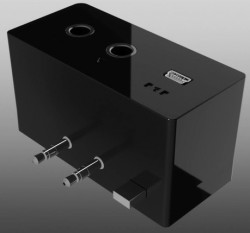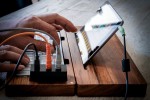Pendeo has introduced two new accessories for the Teenage Engineering OP-1, the Monolith connection adapter & a solid wood case.
 The Pendeo Monolith Adapter allows conversion from the standard 1/8″ audio connectors to 1/4″, using high-quality Neutrik connectors.
The Pendeo Monolith Adapter allows conversion from the standard 1/8″ audio connectors to 1/4″, using high-quality Neutrik connectors.
It connects with the OP-1 easily, for a secure fit which allows reduced wear and stress on the standard OP-1 connectors. The monolith adapter also integrates perfectly with the Pendeo OP-1 Case.
The Pendeo OP-1 Case is machined from solid Burmese Teak, and comes with the Monolith adapter for the OP-1.
A cable channel milled into the inside of case, for storage of the TE USB cable. 8 rare-earth magnets allow easy opening and closing while providing a strong seal.
The top includes a precision machined angled ipad/tablet slot. The bottom includes rubberized anti-slip feet. Inside, there is a polyethylene lining, for pressure fit and shock protection.
Here’s a video introduction to the case & connector:
The Monolith adapter is priced at US $49 and the Pendeo OP-1 Case, with the adapter, is priced at US $229. See the Pendeo site for details.




Now how about one made from pine that costs $30???
Make one just like this out of a less refined wood, exchange the OP-1 with an Akai MPK Mini or similar, add in some sort of an iPad battery charger/USB hub and you will have my money. Add a good headphone amplifier/DAC(or atleast better than the internal iPad one) and you will have more of my money. I´ve been gassing for the Apogee One just for this purpose.
I know it would be more expensive, but I would love such a product enough to pay the extra. Honestly, it would actually make playing around with all my apps fun instead of just interesting and tolerable.
so you blame this company that you own no midi controlller?
Nope, I would just like to carry around one wooden box instead of a bundle of things that tend to wear and tear in my bag. I hate seeing scratches in my stuff, even if it is a cheap controller.
Make an ENTIRELY different product and you will have my money?
Oops, I´m sorry mate. It´s my bad for thinking I could just freely express myself in an online forum. Thanks for the reminder.
No offense, meant, my friend. It just seemed to be an odd comment. Akai was TRYING to get onboard the iPad bandwagon, but the constantly changing connectors became a problem for them. If you go into Guitar Center stores for example, you still find lots of gear that relies on the older connector…not a lightning connector in sight.
Just wanted to add that this looks like a cool product and I would probably buy it if I owned an OP-1. Thanks for the coverage.
True. I would buy it too if I had the OP1. I just would never buy the OP1.
Neither would I, but I would still buy something like this for my iPad. Even if it´s not a popular request.
excellent contribution to the subject.
Can someone make a 3d printed version for less?
I wonder what this gadget has to do with the pro-audi gear on the photo ….
I wonder if you know what you are talking about.
Just how useless and bulky that connector is?! Aren’t mini plug converters a bit more functional?
I think the trick here is that its better to have big phono plugs for interfacing with mixers and other audio gear, plus you are protecting the more delicate mini jacks from possible damage. I think its a very good idea!
Looks very nice, but I question if Burmeese Teak is actually a legal wood to be using. Cutting down teak here in Thailand is generally not legal, and I suspect in Myanmar, it is even more of an ethical question.
Many countries do not allow the export of exotic woods unless they are made into a finished product first. So this product was probably made in Burma.
While there is certainly illegal harvesting of Teak in Myanmar and elsewhere there are also plantations growing sustainable Teak for export. Teak grows very fast compared to other hardwoods.
Provided you have the correct certificates of origin and fumigation exporting is permitted.
I also don’t think this type of wood, or even wood in general, matches the aesthetics of the OP-1. It should be light and matte and Scandinavian, not dark and glossy and Burmese. I associate this look with vintage gear. Other than that it looks awesome.
250$ , more expensive than a Volca , even i knew is for different purpose …..
I don’t like the idea of the jacks being on top. It seems to me it would be easy to break something. It’s also not aesthetically pleasing compared to the rest of it.
Admin: Personal attack deleted. Please keep your comments on topic and constructive.
Well my last comment got censored because it was too colourful. But the fact remains that the decision to use Burmese teak is significantly more controversial than my ex-comment.
I sincerely hope that Pendeo consider their options – something that they may be forced to do by new legislation coming into effect this year.
That said, it remains true that most legislation has thus far been defeated via the route of Chinese exports, but that really only means that the moral imperative shifts to both the manufacturer and the consumer.
Sure it’s a nice looking product, but it is also made from a highly questionable material. Admins, please don’t censor this comment – I’m being fair! Heck if the yacht industry has finally started to change, why on earth does this product need to be made from teak?
At that price, they’re only going to sell a few. A true luxury item.
Someone will most likely come along with something much less expensive.
Its for an $800 niche product, they probably knew of the ‘limited’ market, hence the exotic wood choice.
Don’t mean to offend with the word ‘niche’ – I’ve toyed with the OP-1 and its fun, but simply cannot justify the cost.
My guess is anyone who dished out for an OP-1 will have no qualms with the cost of a beautiful wooden case for it.
OP-1 is not for everyone, but at $800 it’s a bargain among complete production solutions, ones with real hardware controls (for those of us who are not crazy about touch screens). No mere toy either. If you don’t believe “real” music can be made on it, this was done entirely on the device by another user:
https://soundcloud.com/yoof-1/m3ajja2
Personally, I use it more than all of my other synths combined. I’ve made music in iOS, but it’s not nearly as inspiring as the OP-1. It’s easily the biggest bargain in my gear box, no question.
Did Ikea take over Teenage Engineering by any chance?
this could be $20
if it was plastic or pine and had a hole on the side of the case for the audio and usb cable
i hope they release the plans for 3d printing like they did for the knobs
For an OP-1 and iPad mini? This was made for me. I love sampling my iPad on the OP-1. $230 is stiff, but I’ll consider it.